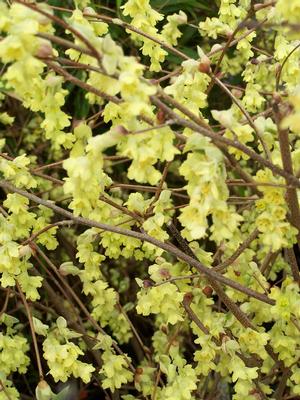View All Plants :: View All DECIDUOUS SHRUBS
Corylopsis pauciflora
Buttercup Winterhazel
Plant Type:
DECIDUOUS SHRUBSCorylopsis pauciflora - Buttercup Winterhazel produces masses of small, pendulous, fragrant primrose yellow flowers in early spring. It's lovely as are all the Winter Hazels when the daffodil days arrive. Site in fertile soil in a semi-shaded to dapple position sheltered from winds if at all possible. Spring planting is advised in the north. Established potted shrub, cutting grown.
Characteristics and Attributes for Corylopsis pauciflora
Season of Interest (Flowering)
- Early Spring
Season of Interest (Foliage)
- Summer / Autumn
Nature Attraction
- Deer Resistant
Light
- Morning Sun / Afternoon Shade
- Shade
- Dappled Shade
Attributes
- Shrub Border
- Hedgerow
- Border
- Fragrant
- Massing
- Specimen
- Woodland
Growth Rate in the Garden
- Medium
Soil
- Fertile
- Draining
- Moist
Origins
- Taiwan
- Japan
Propagated By
- Cutting Grown
Genus Overview: Corylopsis
Winterhazels. I loved seeing them in flower when visiting the Brooklyn Botanic Garden years ago when I lived in New York City. With primrose yellow racemes like a fantastical collection of dangle earrings among all branches they are a delight to behold in early spring. We have ours planted in open to part shade on a gentle slope facing the south and east with under cover of Yoshino cherries adjacent to our Daffodil Walk (with which they simultaneously bloom). Most years they flower beautifully for us getting “hit” only when we have a monster frost that occurs during the bloom cycle. Well, gardening is often an addictive form of Russian roulette! My personal feeling about these and, indeed, all genera in the Hamamelidaceae is that they are garden aristocrats – well-behaved and quietly handsome throughout the growing season, beautiful in bloom and many with good fall color. And though understated in the winter landscape they remain handsome year round… have I said too much!??
All our Winterhazels are cutting grown. Some species are easier from cutting than others. We're always likely to have, for instance, C. spicata selections but not always C. sinensis which we sometimes have trouble getting through the winter. Why? Well, we're clueless!
In northern climes spring planting is highly recommended; also, winter protection is strongly recommended for 2 to 3 years until the shrub truly establishes at the far northern end of its range.


